Activity Characteristics of the East Asian Trough in CMIP5 Models
Abstract
:1. Introduction
2. Data and Methods
3. Results
3.1. Climatological Characteristics of the EAT
3.2. Spatial Modes of EAT Activity
3.3. Characteristic Indices Related to the EAT
3.4. Effects of Model Resolution
4. Conclusions
Acknowledgments
Author Contributions
Conflicts of Interest
References
- Wang, L.; Chen, W.; Zhou, W.; Huang, R.H. Interannual variations of 500 hPa East Asian trough axis and its association with the East Asian winter monsoon pathway. J. Clim. 2009, 22, 600–614. [Google Scholar] [CrossRef]
- Huang, R.H.; Chen, J.L.; Wang, L.; Li, Z.D. Characteristics, processes, and causes of the spatio-temporal variabilities of the East Asian monsoon system. Adv. Atmos. Sci. 2012, 29, 910–942. [Google Scholar] [CrossRef]
- Academia Sinica. On the general circulation over eastern Asia. Part I. Tellus 1957, 9, 432–446. [Google Scholar]
- Ye, D.Z.; Zhu, B.Z. Several Problems of Atmospheric Circulation; Science Press: Beijing, China, 1958. (In Chinese) [Google Scholar]
- Boyle, J.S.; Chen, T.J. Synoptic aspects of the wintertime East Asian monsoon. In Monsoon Meteorology; Chang, C.P., Krishnamurti, T.N., Eds.; Oxford University Press: Oxford, UK, 1987; pp. 125–160. [Google Scholar]
- Lau, K.M.; Li, M.T. The monsoon of East Asia and its global associations—A survey. Bull. Am. Meteorol. Soc. 1984, 65, 114–125. [Google Scholar] [CrossRef]
- Ding, Y.H. Monsoon over China; Kluwer Academic Publishers: Boston, CA, USA, 1994. [Google Scholar]
- Zhou, W.; Chan, J.C.L.; Chen, W.; Ling, J.; Pinto, J.G.; Shao, Y.P. Synoptic-scale controls of persistent low temperature and icy weather over southern China in January 2008. Mon. Weather Rev. 2009, 137, 3978–3991. [Google Scholar] [CrossRef]
- Chang, C.P.; Lau, K.M. Northeasterly cold surges and neat-equatorial disturbances over the winter MONEX area during December 1974. Part II: Planetary-scale aspects. Mon. Weather Rev. 1980, 108, 298–312. [Google Scholar] [CrossRef]
- Zeng, H.L.; Gao, X.Q.; Dai, X.G. Analysis on interdecadal change characteristics of global winter and summer sea surface pressure field and 500 hPa height field in recent twenty years. Plateau Meteorol. 2002, 21, 66–73. (In Chinese) [Google Scholar]
- Li, F.; Jiao, H.Y.; Ding, Y.H.; Jin, R.H. Climate change of Arctic atmospheric circulation in last 30 years and its effect on strong cold events in China. Plateau Meteorol. 2006, 25, 209–219. (In Chinese) [Google Scholar]
- Gong, D.Y.; Wang, S.W.; Zhu, J.H. East Asian winter monsoon and Arctic Oscillation. Geophys. Res. Lett. 2001, 28, 2073–2076. [Google Scholar] [CrossRef]
- Li, C.Y. The frequent activity of East Asian trough and the occurrence of El Niño. Sci. China 1988, 18, 667–674. (In Chinese) [Google Scholar]
- Li, C.Y. Interaction between anomalous winter monsoon in East Asia and El Niño events. Adv. Atmos. Sci. 1990, 7, 36–46. [Google Scholar]
- Xu, J.; Chan, J.C.L. The role of the Asian-Australian monsoon system in the onset time of El Niño events. J. Clim. 2001, 14, 418–433. [Google Scholar] [CrossRef]
- Chang, C.P.; Lau, K.M. Short-term planetary-scales interactions over the tropics and midlatitudes during northern winter. Part I: Contrasts between active and inactive periods. Mon. Weather Rev. 1982, 110, 933–946. [Google Scholar] [CrossRef]
- Ji, L.R.; Sun, S.Q.; Arpe, K.; Bengtsson, L. Model study on the interannual variability of Asian winter monsoon and its influence. Adv. Atmos. Sci. 1997, 14, 1–22. [Google Scholar]
- Li, C.Y.; Mu, M.Q.; Bi, X.Q. Inter-decadal Variations of Atmospheric Circulation Part II: GCM Simulation Study. Chin. J. Atmos. Sci. 2000, 24, 739–748. (In Chinese) [Google Scholar]
- He, S.P.; Wang, H.J. Analysis of the decadal and interdecadal variations of the East Asian winter monsoon as simulated by 20 coupled models in IPCC AR4. Acta Meteorol. Sin. 2012, 26, 476–488. [Google Scholar] [CrossRef]
- Kimoto, M. Simulated change of the East Asia circulation under global warming scenario. Geophys. Res. Lett. 2005, 32, L16701. [Google Scholar] [CrossRef]
- Hu, Z.Z.; Bengtsson, L.; Arpe, K. Impact of global warming on the Asian winter monsoon in a coupled GCM. J. Geophys. Res. 2000, 105, 4607–4624. [Google Scholar] [CrossRef]
- Xu, M.M.; Xu, H.M.; Ma, J. Responses of the East Asian winter Monsoon on global warming in CMIP5 models. Int. J. Climatol. 2016, 36, 2139–2155. [Google Scholar] [CrossRef]
- Wei, K.; Xu, T.; Du, Z.C.; Gong, H.N.; Xie, B.H. How well do the current state-of-the-art CMIP5 models characterise the climatology of the East Asian winter monsoon? Clim. Dyn. 2014, 43, 1241–1255. [Google Scholar] [CrossRef]
- Gong, H.N.; Wang, L.; Chen, W.; Wu, R.G.; Wei, K. The climatology and interannual variability of the East Asian winter monsoon in CMIP5 models. J. Clim. 2014, 17, 1659–1678. [Google Scholar] [CrossRef]
- Hong, J.Y.; Ahn, J.B.; Jhun, J.G. Winter climate changes over East Asian region under RCP scenarios using East Asian winter monsoon indices. Clim. Dyn. 2017, 48, 577–595. [Google Scholar] [CrossRef]
- Kalnay, E.; Kanamitsu, M.; Kistler, R.; Collins, W.; Deaven, D.; Gandin, L.; Iredell, M.; Saha, S.; White, G.; Woollen, J.; et al. The NCEP/NCAR 40-year reanalysis project. Bull. Am. Meteorol. Soc. 1996, 77, 437–471. [Google Scholar] [CrossRef]
- Huang, X.M. A Further Look at the Interannual Variations of East Asian Trough and Their Impacts on Winter Climate of China. Master’s Thesis, Nanjing University of Information Science and Technology, Nanjing, China, 2013. [Google Scholar]
- Mu, M.Q.; Li, C.Y. Interdecadal Variations of Atmospheric Circulation I. Observational Analyses. Clim. Environ. Res. 2000, 5, 233–241. (In Chinese) [Google Scholar]
- Kobayashi, S.; Ota, Y.; Harada, Y.; Ebita, A.; Moriya, M.; Onoda, H.; Onogi, K.; Kamahori, H.; Kobayashi, C.; Endo, H.; et al. The JRA-55 Reanalysis: General specifications and basic characteristics. J. Meteorol. Soc. Jpn. 2005, 93, 5–48. [Google Scholar] [CrossRef]
- Uppala, S.M.; Kållberg, P.W.; Simmons, A.J.; Andrae, U.; Da Costa Bechtold, V.; Fiorino, M.; Gibson, J.K.; Haseler, J.; Hernandez, A.; Kelly, G.A.; et al. The ERA-40 Re-Analysis. Q. J. R. Meteorol. Soc. 2005, 131, 2961–3012. [Google Scholar] [CrossRef]
- Compo, G.P.; Whitaker, J.S.; Sardeshmukh, P.D. The Twentieth Century Reanalysis Project. Q. J. R. Meteorol. Soc. 2011, 137, 1–28. [Google Scholar] [CrossRef]
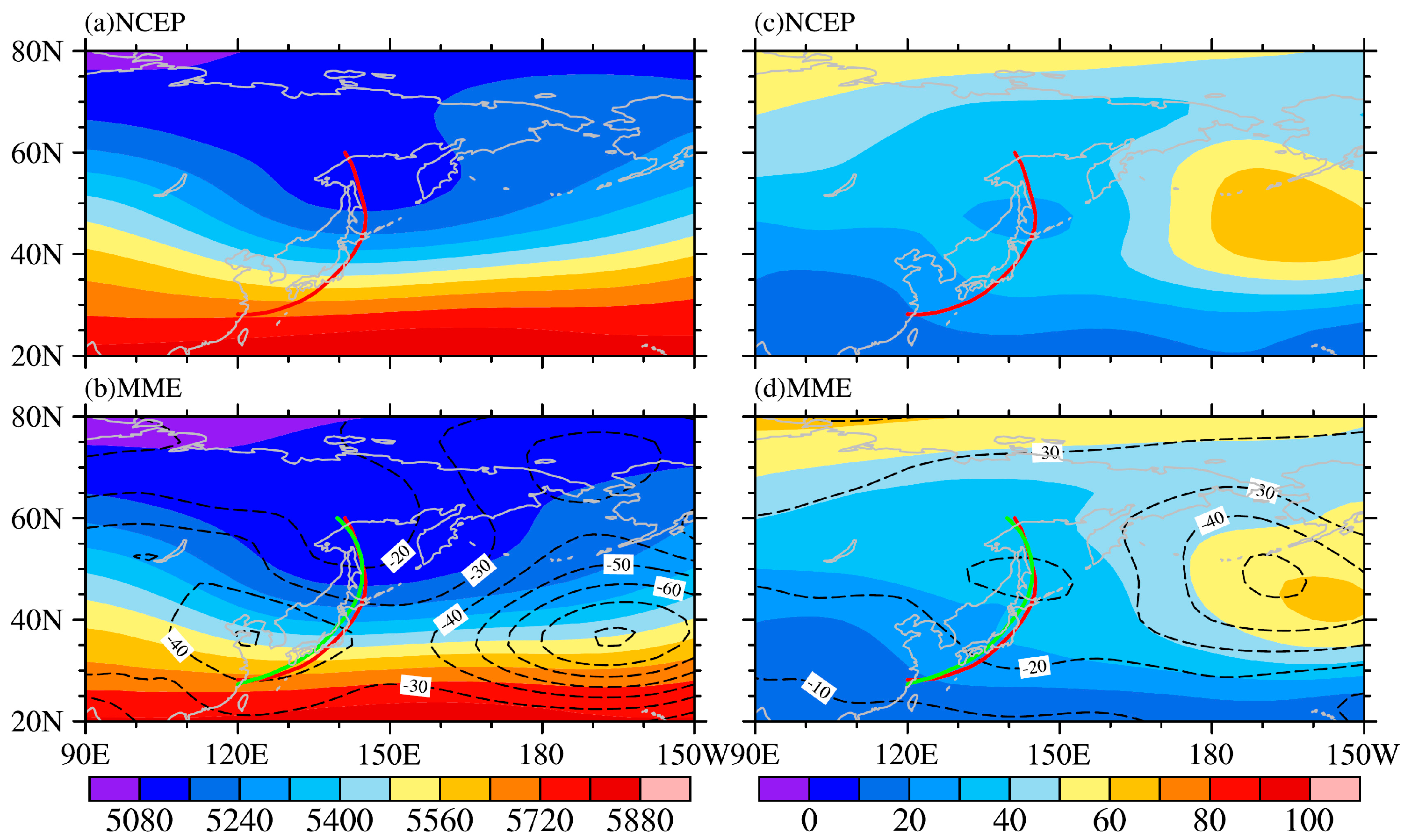
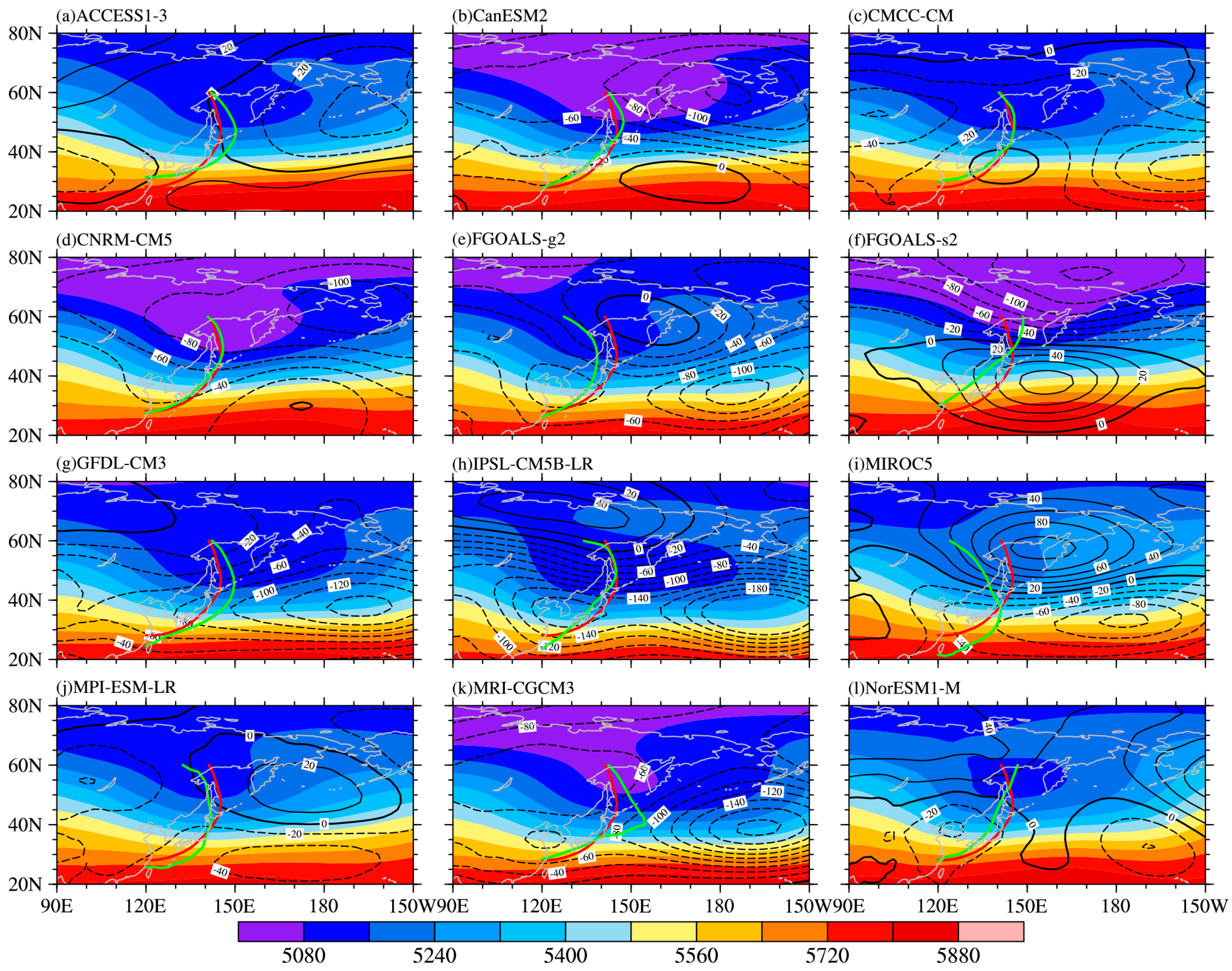
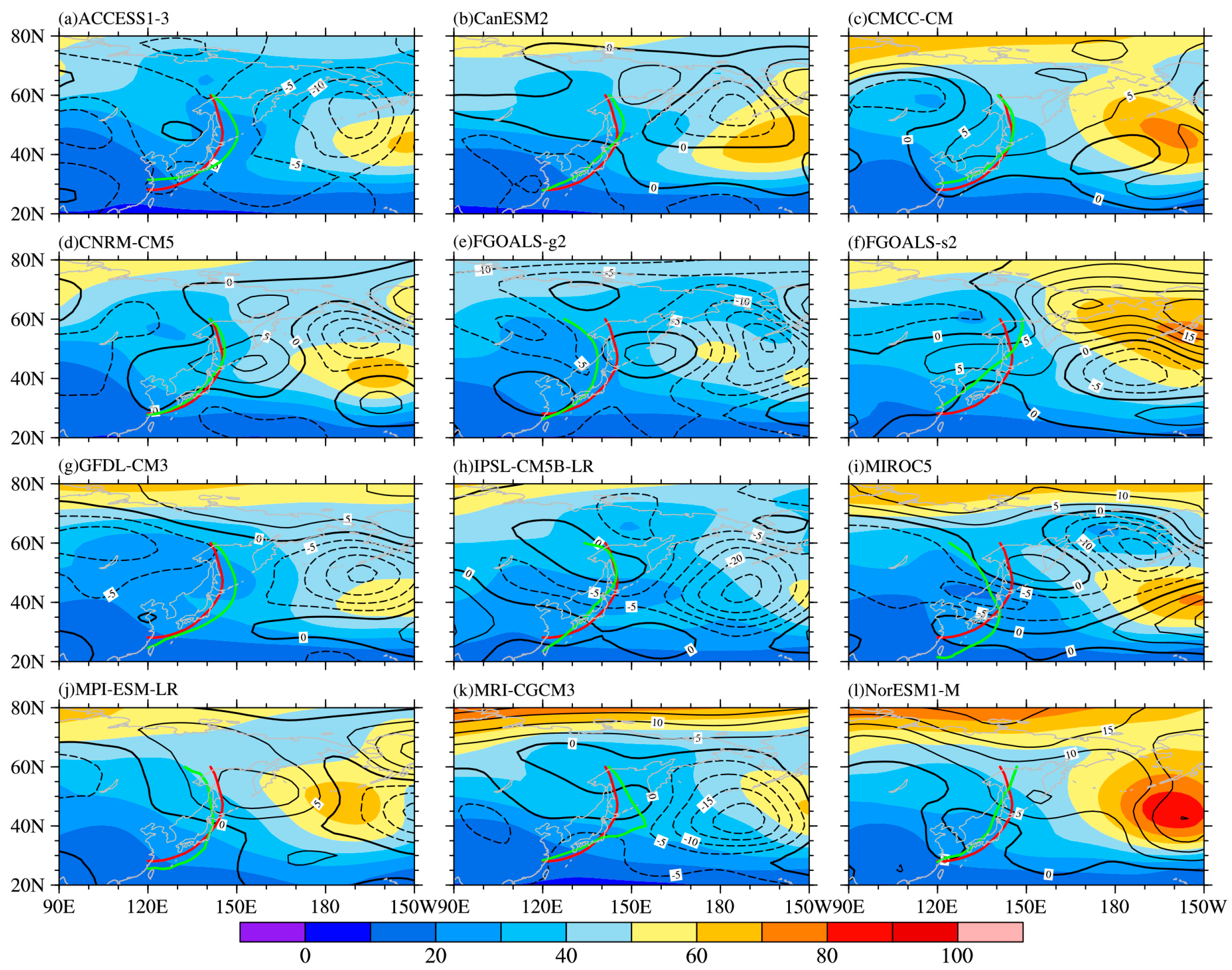


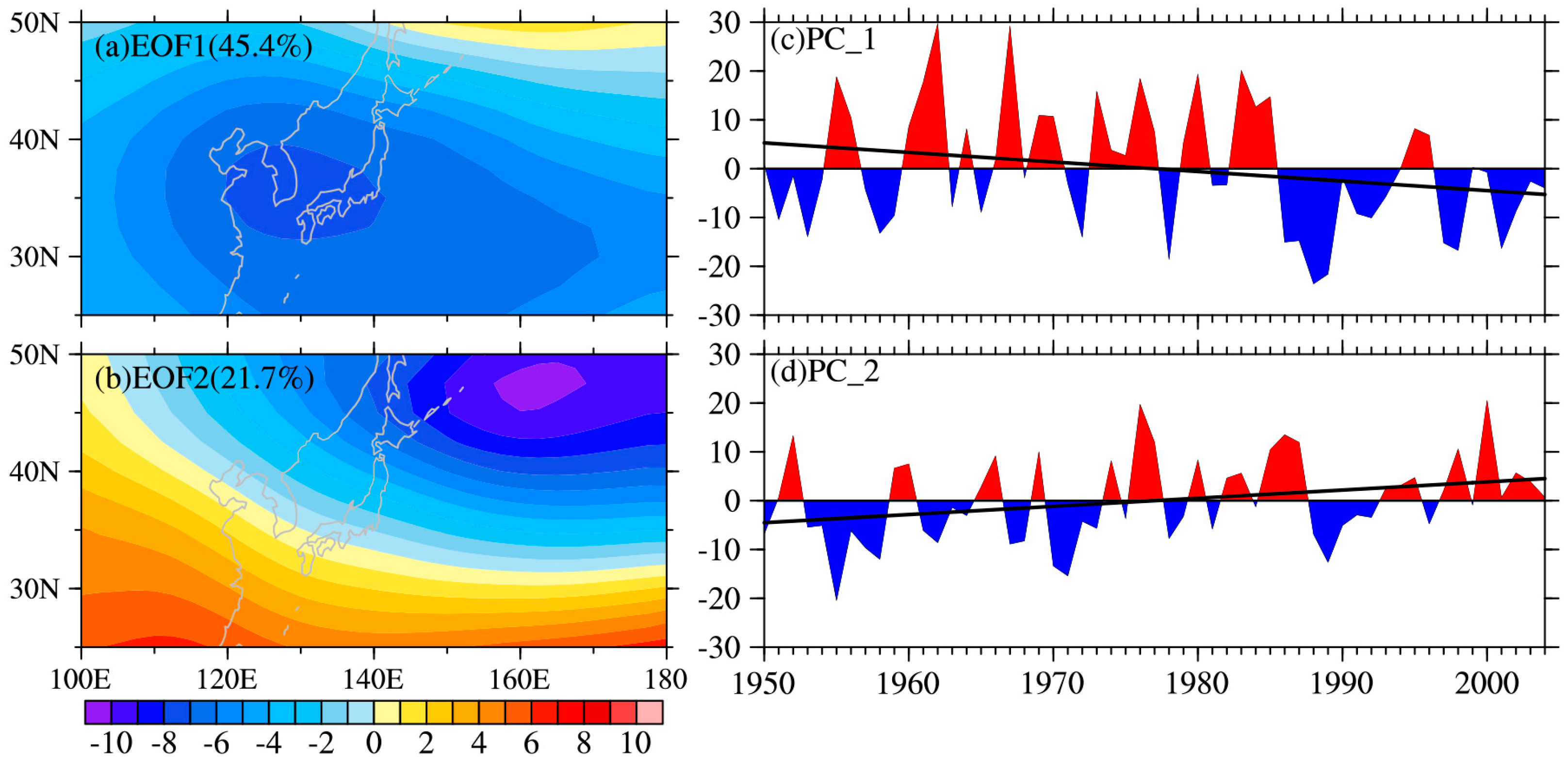

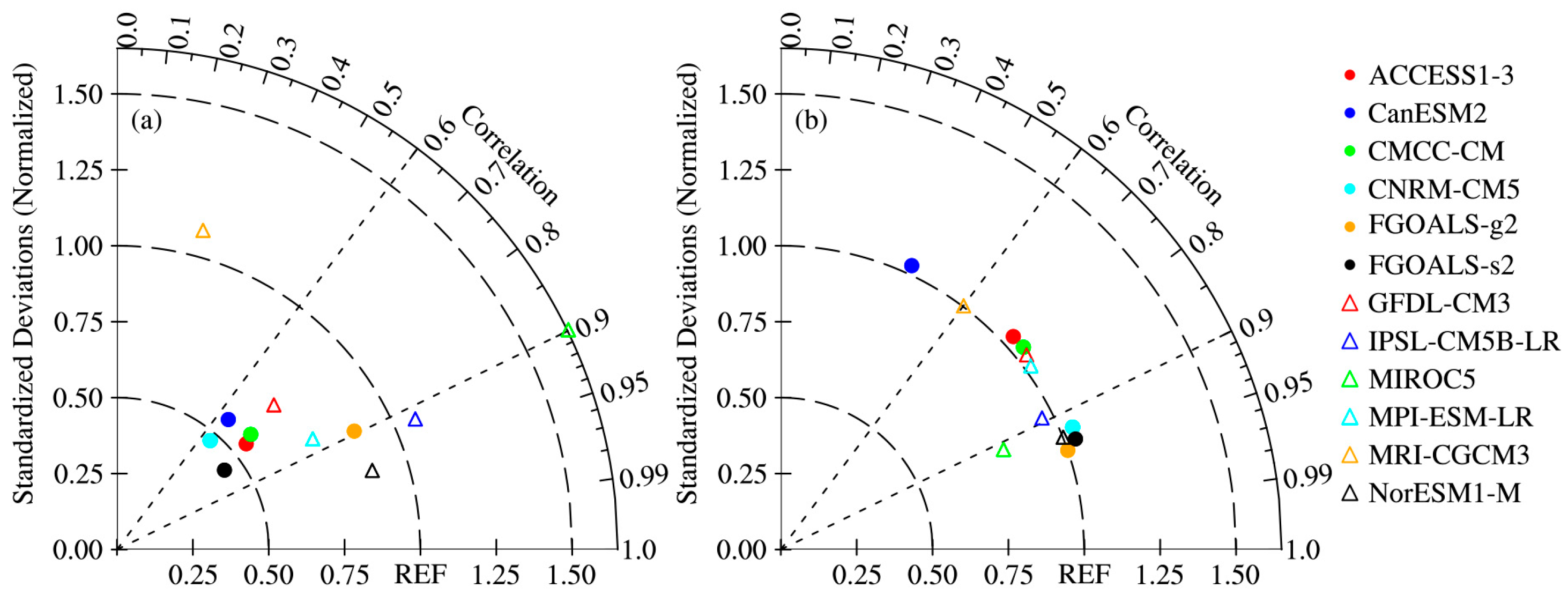
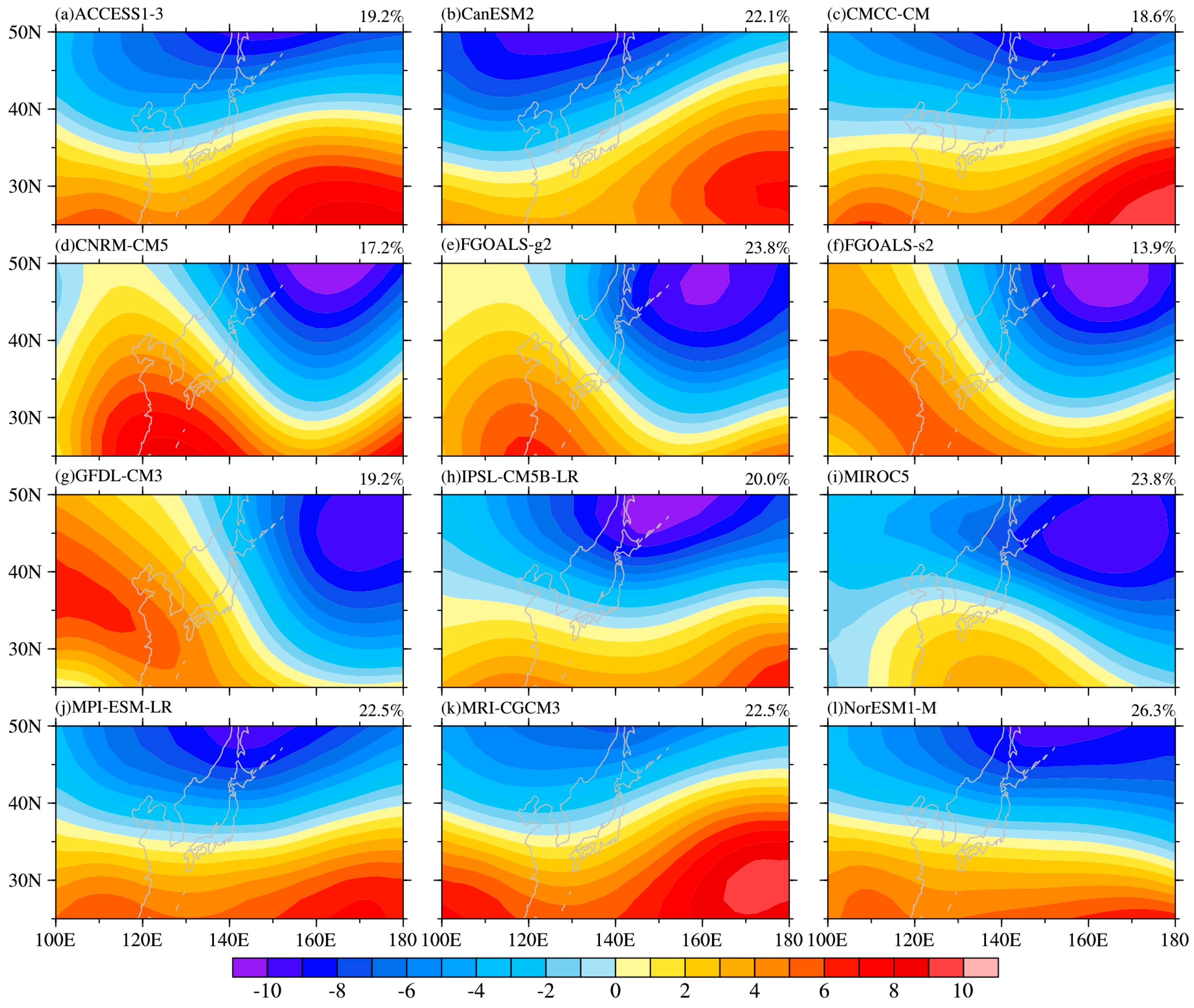
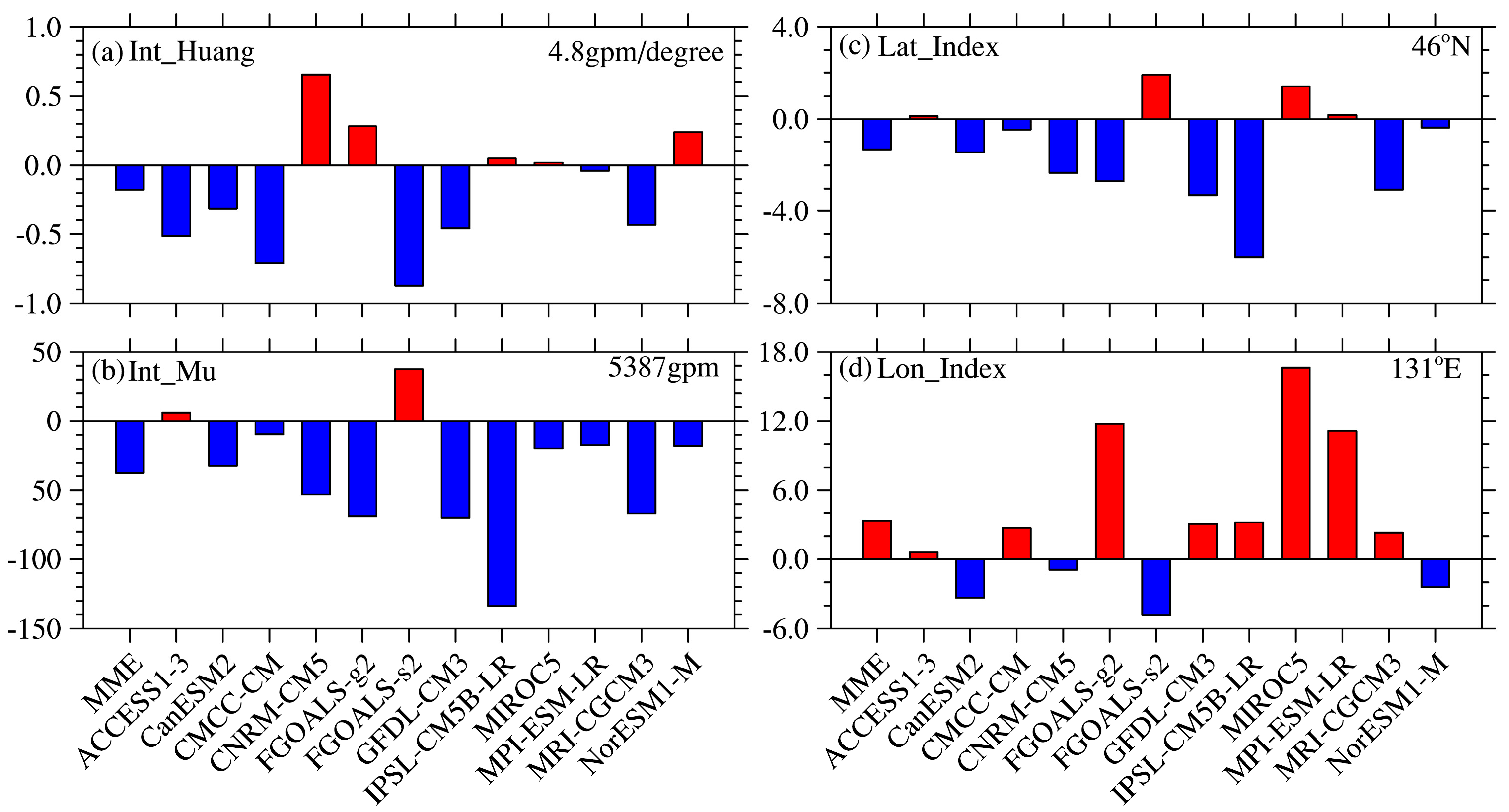
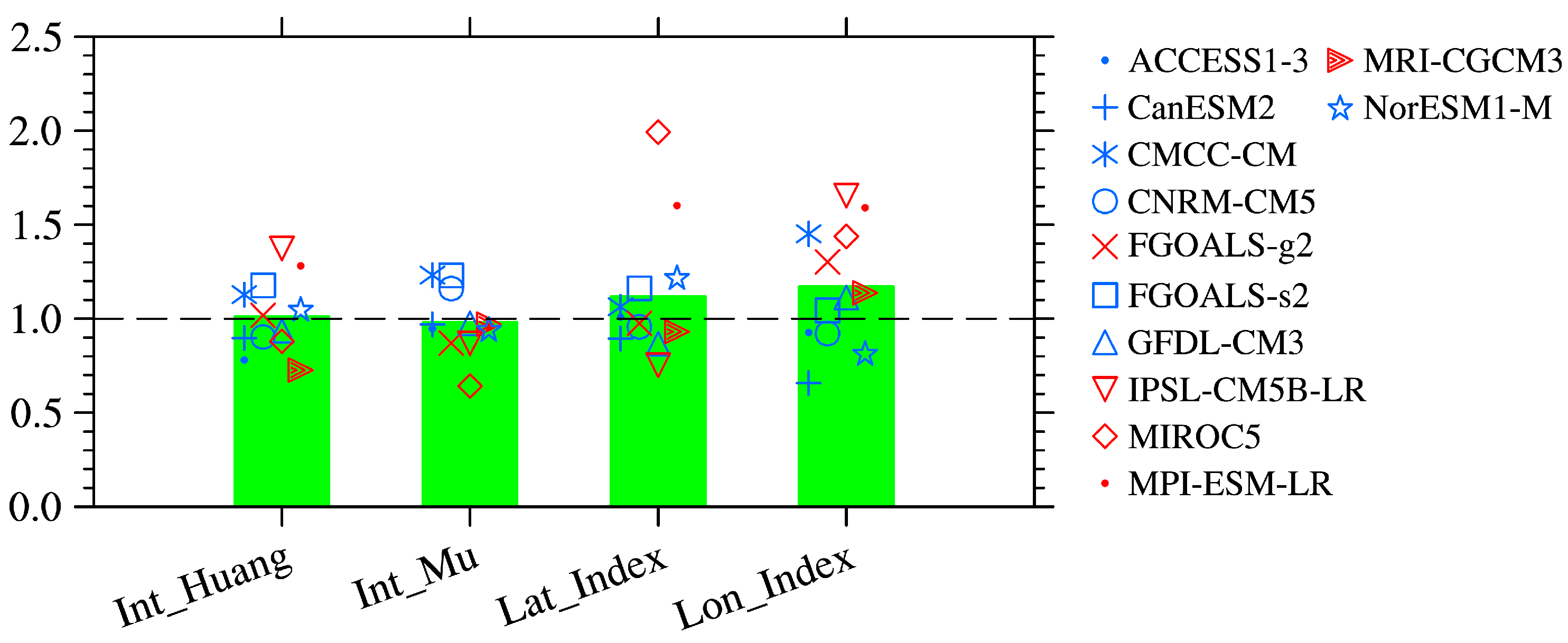
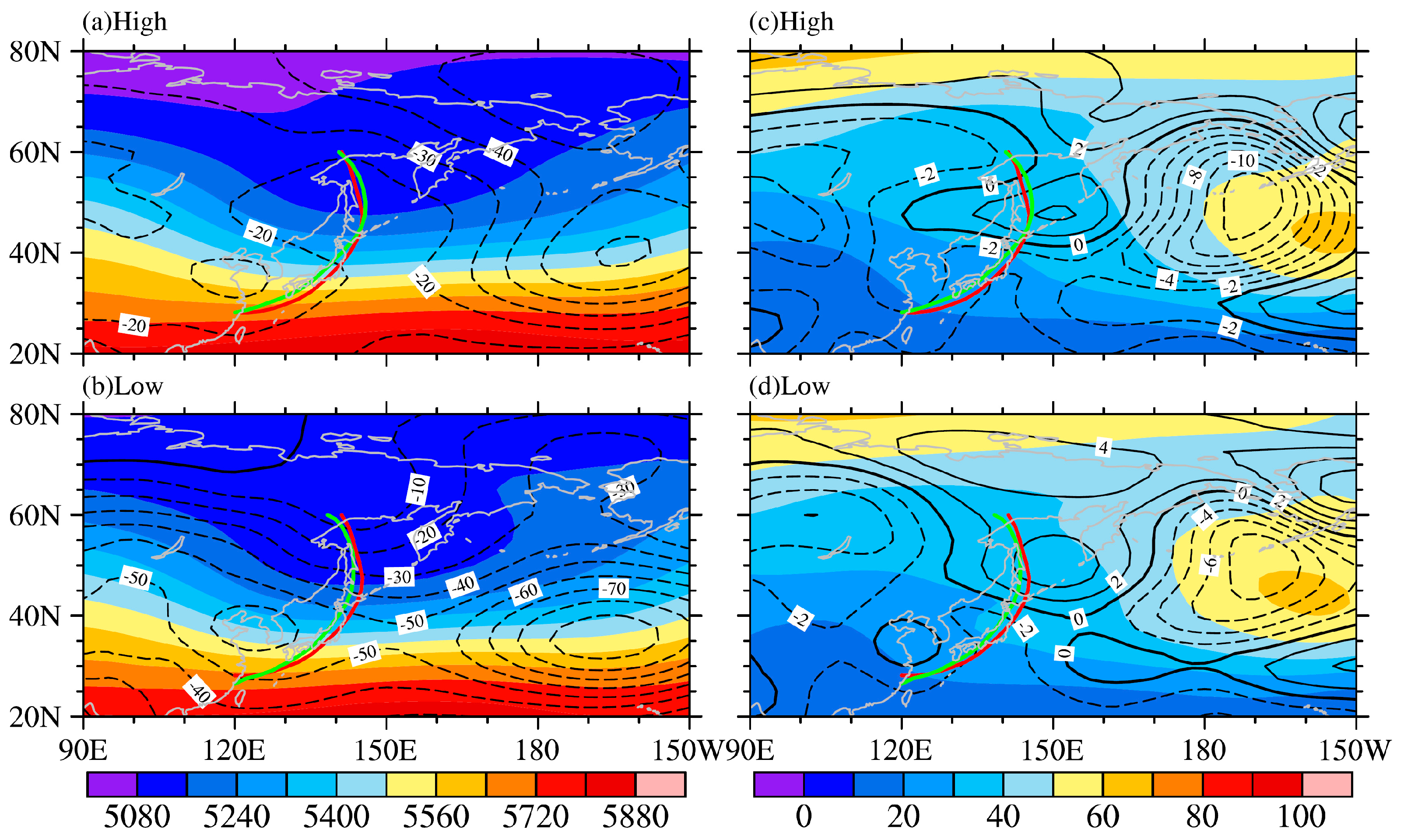
| Model | Institute, Country | Atmospheric Resolution |
|---|---|---|
| Australian Community Climate and Earth-System Simulator, version 1–3 (ACCESS1-3) | BOM, Australia | 192 × 145 |
| Second Generation Canadian Earth System Model (CanESM2) | Canadian Centre for Climate Modelling and Analysis (CCCma), Canada | 128 × 64 |
| Centro Euro-Mediterraneo per I Cambiamenti Climatici Climate Model (CMCC-CM) | Centro Euro-Mediterraneo per I Cambiamenti Climatici (CMCC), Italy | 192 × 96 |
| Centre National de Recherches Météorologiques Coupled Global Climate Model, version 5 (CNRM-CM5) | Centre National de Recherches Météorologiques (CNRM)-Centre Européen de Recherche et de Formation Avancée en Calcul Scientifique (CERFACS), France | 256 × 128 |
| Flexible Global Ocean-Atmosphere-Land System Model (FGOALS) gridpoint, version 2 (FGOALS-g2) | State Key Laboratory of Numerical Modeling for Atmospheric Sciences and Geophysical Fluid Dynamics (LASG), Institute of Atmospheric Physics, Chinese Academy of Sciences and CESS, Tsinghua University, China | 120 × 60 |
| FGOALS, second spectral version (FGOALS-s2) | LASG, Institute of Atmospheric Physics, Chinese Academy of Sciences, China | 128 × 108 |
| Geophysical Fluid Dynamics Laboratory Climate Model, version 3 (GFDL-CM3) | National Oceanic and Atmospheric Administration (NOAA)/Geophysical Fluid Dynamics Laboratory (GFDL), United States | 144 × 90 |
| L’Institut Pierre-Simon Laplace Coupled Model, version 5B, coupled with NEMO, low resolution (IPSL-CM5B-LR) | L’Institut Pierre-Simon Laplace (IPSL), France | 96 × 96 |
| Model for Interdisciplinary Research on Climate, version 5 (MIROC5) | Atmosphere and Ocean Research Institute (AORI)-National Institute for Environmental Studies (NIES)-Japan Agency for Marine-Earth Science and Technology (JAMSTEC), Japan | 256 × 128 |
| Max Planck Institute Earth System Model, low resolution (MPI-ESM-LR) | Max Planck Institute for Meteorology (MPI-M), Germany | 192 × 96 |
| Meteorological Research Institute Coupled Atmosphere–Ocean General Circulation Model, version 3 (MRI CGCM3) | Meteorological Research Institute (MRI), Japan | 320 × 160 |
| Norwegian Earth System Model, version 1 (intermediate resolution) (NorESM1-M) | Norwegian Climate Centre, Norway | 144 × 96 |
| Models | PC1 | PC2 |
|---|---|---|
| Observations | −1.955 * | 1.671 * |
| ACCESS1-3 | 0.040 | −0.002 |
| CanESM2 | −1.275 | −0.831 |
| CMCC-CM | −3.725 * | 0.425 |
| CNRM-CM5 | −0.350 | 0.296 |
| FGOALS-g2 | −2.483 * | 0.244 |
| FGOALS-s2 | −5.730 * | 0.301 |
| GFDL-CM3 | 0.066 | 0.248 |
| IPSL-CM5B-LR | −2.436 * | 1.401 * |
| MIROC5 | −0.825 | 1.199 |
| MPI-ESM-LR | −3.430 * | 1.152 |
| MRI-CGCM3 | −1.720 * | −0.755 |
| NorESM1-M | −1.589 | −0.290 |
| Index | Climatological Mean | Ratios of Interannual Standard Deviation | ||
|---|---|---|---|---|
| High/Low group | High | Low | High | Low |
| Int_Huang | −0.229 | −0.136 | 1.013 | 1.098 |
| Int_Mu | −19.27 | −49.98 | 0.981 | 0.974 |
| Lat_Index | −0.382 | −2.013 | 1.119 | 1.054 |
| Lon_Index | 2.755 | 3.737 | 1.171 | 1.227 |
© 2018 by the authors. Licensee MDPI, Basel, Switzerland. This article is an open access article distributed under the terms and conditions of the Creative Commons Attribution (CC BY) license (http://creativecommons.org/licenses/by/4.0/).
Share and Cite
Chen, X.; Liu, X.; Li, X.; Liu, M.; Yang, M. Activity Characteristics of the East Asian Trough in CMIP5 Models. Atmosphere 2018, 9, 67. https://doi.org/10.3390/atmos9020067
Chen X, Liu X, Li X, Liu M, Yang M. Activity Characteristics of the East Asian Trough in CMIP5 Models. Atmosphere. 2018; 9(2):67. https://doi.org/10.3390/atmos9020067
Chicago/Turabian StyleChen, Xiong, Xing Liu, Xin Li, Mingyang Liu, and Minghao Yang. 2018. "Activity Characteristics of the East Asian Trough in CMIP5 Models" Atmosphere 9, no. 2: 67. https://doi.org/10.3390/atmos9020067
APA StyleChen, X., Liu, X., Li, X., Liu, M., & Yang, M. (2018). Activity Characteristics of the East Asian Trough in CMIP5 Models. Atmosphere, 9(2), 67. https://doi.org/10.3390/atmos9020067





